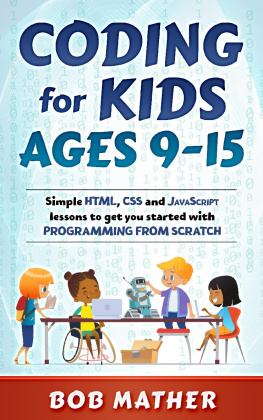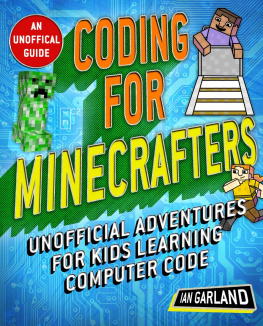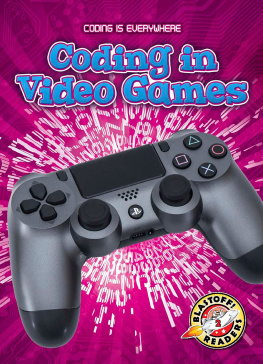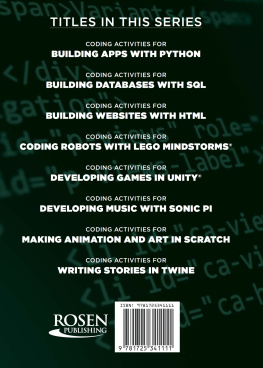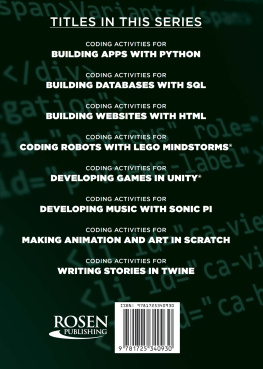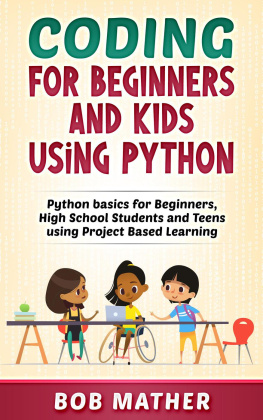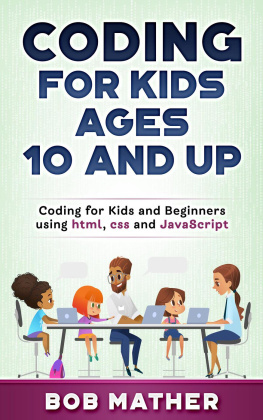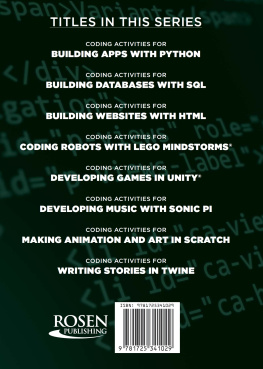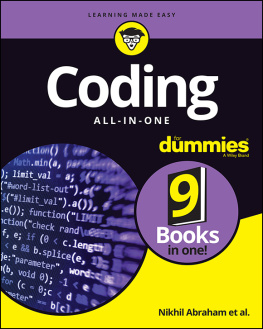TEACHING CODING THROUGH GAME CREATION
Sarah Kepple

Copyright 2018 by Sarah Kepple
All rights reserved. No part of this publication may be reproduced, stored in a retrieval system, or transmitted, in any form or by any means, electronic, mechanical, photocopying, recording, or otherwise, except for the inclusion of brief quotations in a review, without prior permission in writing from the publisher.
Library of Congress Cataloging-in-Publication Data
Names: Kepple, Sarah, author.
Title: Teaching coding through game creation / Sarah Kepple.
Description: Santa Barbara : ABC-CLIO, [2018] | Includes bibliographical references and index.
Identifiers: LCCN 2018021624 (print) | LCCN 2018026221 (ebook) | ISBN 9781440851896 (ebook) | ISBN 9781440851889 (hard copy : alk. paper)
Subjects: LCSH: Computer gamesProgramming. | Computer programmingStudy and teaching (Elementary) | EducationData processing.
Classification: LCC QA76.76.C672 (ebook) | LCC QA76.76.C672 K48 2018 (print) | DDC 794.8/1525dc23
LC record available at https://lccn.loc.gov/2018021624
ISBN: 978-1-4408-5188-9 (paperback)
978-1-4408-5189-6 (ebook)
222120191812345
This book is also available as an eBook.
Libraries Unlimited
An Imprint of ABC-CLIO, LLC
ABC-CLIO, LLC
130 Cremona Drive, P.O. Box 1911
Santa Barbara, California 93116-1911
www.abc-clio.com
This book is printed on acid-free paper 
Manufactured in the United States of America
For Andy, who thinks I can do anything, and
who encourages me to try.
Contents
Preface
I dont quite remember when my family got our first computer, but I know we had it by the time I was in second grade because I remember having a slumber party that year, during which my friendsnone of whom had computers at homeall wanted to play on it until the wee hours of the morning. I certainly didnt mind. I can still remember the text commands we needed to enter to load games from floppy disks onto the Commodore 64 (for those who are curious, it was and is LOAD FROGGER, 8, 1 ). I felt very fortunate then, but I didnt realize just how impactful having a home computer from such a young age would be on my life.
Having a father who was fascinated by the latest advances in technology meant that we always had a computer keeping up with the times, that I could type, use a mouse and comprehend basic computer mechanics from a young age. We had internet before any of our rural neighbors, and I could type and print my school papers at home rather than wait for shared time on the one Apple IIe in class. Most importantly, it meant that I viewed technology as a tool to be learned and used, not feared.
As I advanced into college and the workforce, I often found myself helping friends and colleagues figure things out. If the organization had a tech team I was on it, and in some cases leading it. If I came across a mundane problem I tried to find a technological solution. I never viewed myself as a particularly knowledgeable or passionate about technology, but the longer I worked in libraries, the more I realized that my combination of fearless curiosity, service to others, and interest in education was a particular type of technology expertise.
SCOPE
I am not a professional programmer. I have taken no more than one college-level coding class. What I have done is identify the changing technology needs of library customers and help empower staff to respond to them. If youre trying to figure out how to lead coding classes in libraries, then this is the book for you. Ive developed these lessons by leading them more times than I can count in a diverse array of libraries and tweaking them over and over.
I wrote my previous book, Library Robotics: Technology and English Language Arts Activities For Ages 824 , to answer the questions that we had when our little robotics team at Cuyahoga County Public Library was trying to figure out how in the world we were going to get started. At the time, I could find resources on how robots worked or take programming classes, but they were geared toward math, physics, or computer science teachers, not complete newbies, and they didnt take into account the unique realities of educating in libraries. Likewise, there are many coding books available that can help readers build deeper knowledge of the coding languages mentioned within these pages, but Im not familiar with any other books that are geared specifically toward librarian instructors. This book is intended to help those with little to no experience build confidence and competence, so that they can get started leading coding experiences in their libraries.
HOW TO USE THIS BOOK
Each chapter may be used as a standalone class, though there is more content per chapter than a typical class will learn in a two-hour window. Some chapters include activity sets, groups of smaller lessons that work together toward a larger concept. Each activity in these sets may be an individual class when working with younger students or limited time.
The intent of the book is to provide a librarian with the background and content to be able to lead at least ten coding club sessions. Every librarys needs are different, and the Introduction provides some guidance to libraries that are considering how best to get started.
I highly recommend that potential instructors work through at least the first few chapters before beginning a new club. The chapters are written in a voice to help the potential instructor learn how to program and think about how to help the class understand the same concepts. Downloadable, printable student handouts are available from the link in the Appendix.
VOCABULARY
Throughout this book the term program and its variations are used exclusively in their technological sense, rather than in reference to educational and entertainment events hosted by public libraries. This is done not only to avoid confusion, but also to encourage librarians to use more intentional and accurate language about our educational efforts. Each of these chapters could be a class .
The term librarian is used broadly, and is welcome to be claimed by any reader employed by a library who is willing to take up the causes of computational thinking, technology literacy, and coding. Thank you for everything you do.
Introduction
Those working in libraries, schools, or any education-related field have probably heard a lot of buzz about coding, but many may feel a little unsure of what exactly it is or how best to approach the subject. This introduction attempts to explain what coding is, how it intersects with the mission of libraries, and offers some considerations for getting started. Well address both the traditional and the colloquial definitions of coding and examine its role and influence in our society. Well explore how coding intersects with library priorities and address points to consider before launching a coding initiative.
WHY CODING
For adults with fond memories of classic 1980s movies like War Games , Weird Science , and Tron, coding might seem like something only super geniuses do on custom built computers, but nowadays, not only is coding accessible to most, its applicable to far more than computers. Mobile phones, tablets, and video game consoles need programs to tell them what to do, and an increasing number of appliances use programming, too. Washing machines and dishwashers arrive programmed with different cycles that determine the agitation level, water temperature, and cycle length. The amount of programming in cars continuously increases, from monitoring speed, temperature, emissions, and service dates to interfacing with smartphones and navigation systems and detecting potential accidents. We interact with multiple programs and programmed devices each and every day and may not even know it.
Next page


